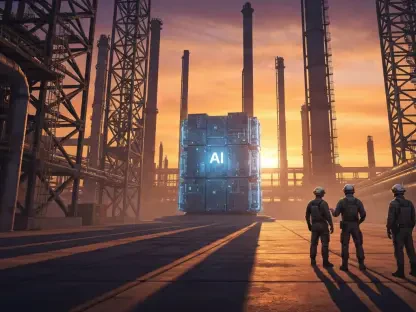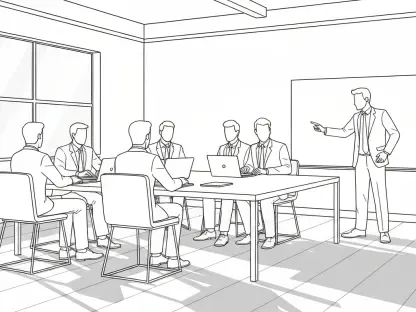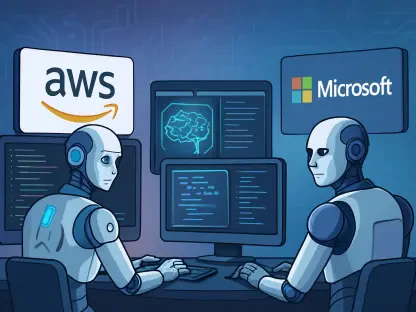In the dynamic landscape of artificial intelligence (AI), a profound challenge persists in aligning machine vision with the intricate ways humans perceive and interpret the world around them, a gap that groundbreaking research published in Nature by Muttenthaler et al. seeks to address. This study delves into how deep learning models can be refined to mirror human conceptual understanding across various levels of abstraction. It stands at the crossroads of AI and cognitive science, tackling a critical gap where machines often fall short of grasping the hierarchical and nuanced relationships that humans instinctively recognize. As AI becomes increasingly embedded in critical applications—think autonomous driving or diagnostic imaging—the need to close this cognitive divide has never been more urgent. This exploration not only highlights the limitations of current technology but also unveils innovative strategies to harmonize machine perception with human thought, promising a future where technology can truly see through human eyes.
Unpacking the Cognitive Divide
The disparity between human and machine vision lies at the heart of many AI shortcomings. Humans possess a remarkable ability to categorize visual input into layered, meaningful structures, identifying similarities not just based on appearance but on abstract concepts like function or context. For instance, a person can group a lion and a house cat as “felines” despite stark visual differences, a feat that relies on deep semantic understanding. In contrast, most deep learning models focus on superficial traits, such as color or texture, often missing the broader connections that define human reasoning. This mismatch becomes evident in tasks requiring nuanced similarity judgments, where machines consistently fail to replicate the multi-dimensional thought processes inherent to human perception. The consequences of this gap are significant, particularly in scenarios where precise and context-aware decisions are critical, exposing a fundamental limitation in the current state of visual recognition technology.
This cognitive divide is more than a technical hurdle; it represents a barrier to creating AI that can operate seamlessly alongside humans. When machines misinterpret visual data due to their inability to process abstract hierarchies, the results can range from minor inconveniences to major errors in high-stakes environments. Consider medical imaging systems that might overlook subtle patterns a trained human eye would catch, simply because the model lacks the conceptual depth to connect disparate visual cues. The research underscores how these failures stem from an over-reliance on raw data patterns without the guiding framework of human-like semantic organization. Addressing this issue requires a fundamental shift in how models are designed and trained, moving beyond mere accuracy metrics to prioritize alignment with the intricate ways humans structure and interpret visual information in their minds.
Innovating with Human-Centric Data
To tackle the challenge of aligning machine vision with human cognition, researchers have introduced a transformative approach rooted in human perception. A meticulously crafted dataset known as “Levels” serves as the foundation, capturing how people assess similarity across visual stimuli at both surface and deeper conceptual levels. This dataset revealed a stark truth: existing vision models struggle to emulate the complex, hierarchical structures that underpin human thought. Rather than merely highlighting deficiencies, “Levels” acts as a benchmark to guide improvement, offering a window into the nuanced ways humans connect visual elements beyond obvious traits. By mapping these perceptions, the study lays the groundwork for a methodology that can reshape how machines process and understand visual input, aiming for a closer match to human cognitive patterns.
Building on this insight, the research team devised a novel two-step framework to embed human-like reasoning into AI systems. Initially, a limited set of human similarity judgments was used to train a surrogate “teacher” model, which then produced a vast synthetic dataset called “AligNet.” This dataset encapsulates the semantic structures reflective of human understanding, serving as a bridge between raw data and conceptual depth. In the subsequent phase, existing vision foundation models were fine-tuned using AligNet, effectively integrating these human-aligned structures into their internal representations. The outcome is striking—models not only demonstrate improved alignment with human judgments but also exhibit enhanced performance and robustness in diverse real-world tasks. This approach marks a significant leap forward, illustrating that machine vision can evolve to reflect the layered complexity of human perception through targeted, data-driven innovation.
Redefining Neural Network Potential
A longstanding skepticism in the AI community has been whether neural networks can genuinely capture abstract or hierarchical concepts without explicit programming or architectural tweaks. This research challenges that doubt head-on, demonstrating that such sophisticated structures can indeed emerge organically when models are trained with data reflecting human similarity judgments. The inductive bias provided by human-centric datasets like AligNet acts as a subtle guide, steering models toward representations that are more interpretable and aligned with cognitive processes. This finding is a game-changer, suggesting that the path to cognitive alignment does not necessitate labor-intensive manual design but can be achieved through strategic use of data that mirrors human thought patterns, opening new avenues for scalable and effective AI development.
The implications of this discovery extend far beyond theoretical debates, offering practical insights for enhancing AI capabilities. By showing that hierarchical understanding can be distilled into models without hardcoded rules, the study paves the way for more flexible and adaptive systems. This is particularly relevant in dynamic environments where predefined categories may not suffice, and machines must learn to generalize across novel contexts much like humans do. The success of this data-driven approach also underscores the value of interdisciplinary collaboration, blending insights from cognitive science with computational techniques to push the boundaries of what neural networks can achieve. As a result, the field stands on the cusp of a paradigm shift, where the limitations once thought inherent to artificial systems are increasingly seen as surmountable through innovative training methodologies.
Expanding Horizons Across AI Domains
The ripple effects of aligning vision models with human cognition are not confined to visual recognition tasks alone. The research hints at exciting possibilities in other AI domains, such as natural language processing (NLP), where models often grapple with capturing the subtleties of meaning and context. Just as vision systems can be tuned to understand hierarchical visual relationships, language models could be refined to better grasp syntactic and semantic nuances by adopting similar alignment strategies. Imagine chatbots or translation tools that comprehend idiomatic expressions or cultural references with human-like finesse, significantly improving their utility and accuracy. This cross-disciplinary potential highlights how principles from cognitive science can inform broader AI advancements, fostering systems that resonate more closely with natural intelligence.
Moreover, this alignment paradigm signals a shift toward a more integrated approach in AI research, where insights from psychology and neuroscience play a pivotal role. The success in vision models serves as a proof of concept, encouraging exploration into how human cognitive frameworks can enhance machine understanding across varied applications. From improving recommendation algorithms to refining decision-making tools in complex fields like finance or logistics, the methodology offers a blueprint for creating AI that not only performs tasks but does so with a depth of understanding akin to human reasoning. This trend toward interdisciplinary innovation is poised to redefine the trajectory of AI, ensuring that technological progress aligns more closely with the intricacies of human thought and interaction in diverse real-world scenarios.
Building Trust Through Alignment
As AI systems increasingly permeate high-stakes sectors like healthcare, security, and transportation, establishing trust in their functionality becomes paramount. Missteps in these areas can have profound consequences, making the alignment of machine vision with human cognition a critical step toward reliability. By embedding human-like semantic structures into models, the research offers a pathway to systems that are not only more accurate but also more transparent in their decision-making processes. When machines reason in ways that parallel human thought, their outputs become easier to interpret, fostering confidence among users who rely on these technologies for critical decisions, whether diagnosing a medical condition or navigating a busy intersection.
This focus on interpretability also addresses ethical considerations surrounding AI deployment. Systems that align with human cognitive patterns are less likely to produce unexpected or erratic results, reducing the risk of harm in sensitive applications. Furthermore, transparency in how decisions are reached can help mitigate concerns about accountability, a growing issue as AI takes on more autonomous roles. The alignment strategy thus serves a dual purpose—enhancing technical performance while building a foundation of trust that is essential for widespread acceptance. As society grapples with the integration of AI into daily life, such advancements ensure that technology remains a dependable partner, harmonizing computational precision with the intuitive depth of human understanding.
Navigating Future Challenges
While the strides made in aligning AI with human vision are impressive, the journey is far from complete. One pressing challenge is the inability of current models to fully account for contextual or cultural variations in human perception. What one group might see as similar based on shared cultural norms, another might interpret differently, and machines must adapt to these subtleties to avoid misjudgments. Additionally, there’s the risk of perpetuating human biases embedded in the training data, which could skew outcomes in unintended ways. These hurdles underscore the importance of continued refinement, ensuring that alignment strategies evolve to encompass the full diversity of human experience without reinforcing existing inequities or oversights in understanding.
Looking forward, the research sets a compelling agenda for future exploration in AI development. Addressing these limitations will require not only technical innovation but also a deeper engagement with fields like anthropology and sociology to better capture the spectrum of human cognition. The potential to refine datasets and algorithms to reflect varied perspectives offers a promising direction, as does the development of mechanisms to detect and mitigate bias during training. As efforts progress over the coming years, the focus must remain on creating systems that are inclusive and adaptable, capable of navigating the complexities of human thought across different contexts. This ongoing work holds the key to unlocking AI’s full potential, ensuring it serves as a true extension of human capability in an ever-changing world.









